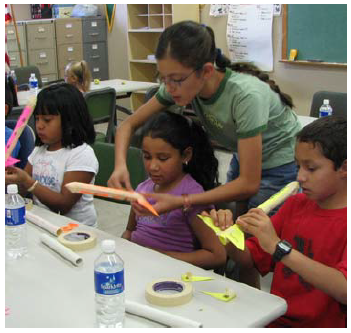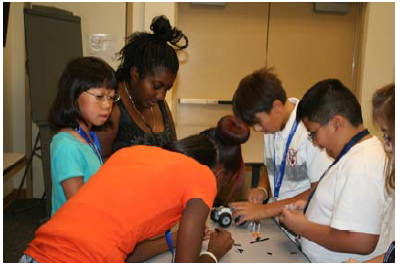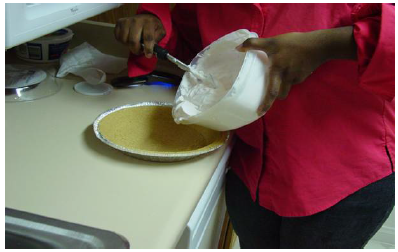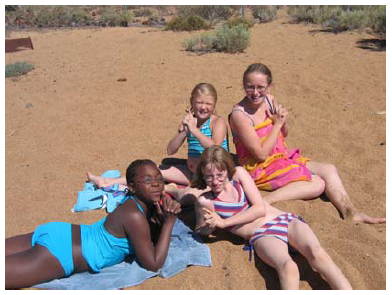Background
Good program planning, rather than luck, is considered to be the bedrock of successful Extension programs (Casey & Krueger, 1991). According to researchers Brown (1982) and Copa (1986), effective program planners, as they look at urban programs, should take several things into consideration:
- Promoting and creating ideas and programs for the people in the communities.
- Setting program priorities and focusing energy on the most important program.
- Having the ability to look ahead or creating a vision and anticipating audience needs, and developing contingency plans to meet those needs; strategically thinking ahead and working with the plan.
What do we need to know as we deliver programs in an urban environment?
Most urban environments are diverse so we have to consider this factor as we deliver programs. Hobbs (2004), working with a certain ethnic 4-H group, recognized this important factor and acknowledged that although changes were made to accommodate this group, the changes should not make them a lesser part of the Extension program, and that the participants simply represent an expansion of the methods used to fulfill its mission. Woodson and Calhoun (2006) reported that implementing successful programs with African- American faith communities required diversity in planning and delivering and is very labor intensive.
- We need to be familiar with the Experiential Learning Model of “Do," “Reflect” and “Apply.” This serves as the theoretical framework for teaching and assessing program activities.
- We need to identify, with the help of youth, the “needs” that will drive the programs.
How do we deliver urban 4-H programs to youth?
One of the first steps in delivering 4-H programs to urban youth is to try to understand what the “need” is and to develop programs around those needs. The youth in the urban setting are in no way different from the youth in rural and/or suburban areas in terms of needs.
However, the method of delivery can be different or at least be designed to accommodate those in the urban environment. As an example, the use of an “Adopt a Pet” using small animals such as cavies or rabbits can be used instead of larger animals such as horses and steer to teach responsibility as a life skill. The next steps to consider as we work with urban youth are:
- Networking, partnering and collaborating with youth groups and agencies willing to work with 4-H.
- Taking the programs to the youth.
- Offering something that is unique and different from other agencies.
One of the strengths of University of Nevada Cooperative Extension’s 4-H program is that it is research-based and educational.
The greatest challenge in working with an urban 4-H program is getting the youth together. Unlike a rural environment, there are many other ongoing activities in the inner cities. 4-H, as with other youth agencies, has to compete for the youth population. Unlike the rural areas, there is less parental involvement in the programs.
Additionally, in the inner cities, 4-H has to rely on centers or schools, both of which can be difficult to organize. To reduce these challenges, strong partnerships with other agencies are encouraged. This might lead to identifying locations for meetings. In a recent experiment completed in Clark County, the hurdles of overcoming meeting locations were accomplished through networking, partnering, and collaborating with school, city community centers and faith-based sites. This method was used to promote and increase youth involvement in Nevada’s 4-H.
The structure of urban 4-H
The structure of 4-H in an urban setting lends itself primarily to groups in which youth and adults can work together as partners as they develop life skills. This is one of the best formats for 4-H. Research shows that youth who work in groups can improve intellectually, expand their interests and increase their confidence.
Youth who work in groups learn how to work in teams and will make rapid progress in whatever they do. Effective group dynamics also improves classroom behavior. Research shows that adult leaders, or instructors, should work as guides or facilitators, to allow for youth learning to take place.
4-H Programs
4-H programs enhance and develop life skills in youth that help them become contributing members of society. The programs are research-based and are used as tools to develop knowledge, life skills such as critical thinking, problem solving, decision making, teamwork and positive attitude changes toward their future goals.
In a recently conducted needs assessment for Clark County (Barker 2011), the following program needs were identified:
- Volunteer Recruitment and Leader Training
- 4-H Life Skill Development and Membership Recruitment
- Science, Technology, Engineering and Math (S.T.E.M.) through the National 4-H Science, Engineering & Technology (4-H S.E.T.) Initiative
- General 4-H and Club Program for new and existing clubs
To focus on identified needs, one should consider the curricula and programs that will solve the problems or concerns. Curricular level programs should be geared towards: (1) knowledge acquisition within the subject matter area; (2) skill development such as problem solving, critical thinking, decision making and teamwork; and (3) attitudinal changes.
Targeted audiences are diverse and include an urban and rural population of youth, adults and traditional students (K-12). Outcomes can be achieved via direct teaching to small and large groups, one-on-one consultation with affected interests, leading and/or participating at program sites, making educational presentations at workshops and conducting outreach activities.
Current Work Programs
The expansion of the 4-H Youth Development program to larger and more diverse audiences can be accomplished through four methods:
1. Volunteer Recruitment and Leadership Development Training Program(s)
Need and Teaching Strategy
Volunteer recruitment and leadership development are critical first steps in responding to youth engagement in Clark County’s 4-H program (focus group results, SP-10-05). 4-H is a volunteer-driven program. The quality of clubs is directly related to the quality of volunteers leading the clubs. Research indicates that success in youth development is dependent on a caring adult working in partnership with youth (Camino, 2000).
Volunteer leaders need to develop the necessary competencies to be able to deliver 4-H. They need to understand the “ages and stages of youth development,” the “experiential learning model” and the “critical elements of youth development,” as well as develop an understanding that 4-H is a life skill development program.
The Volunteer Recruiting and Training program has two parts: (1) volunteer leaders volunteering in the Introduction to 4-H program and (2) leaders for the community 4-H clubs or the already established clubs.
For both parts (1) and (2) of the Volunteer Recruiting and Training program, in-depth training class and workshop sessions include: (a) the critical elements of youth development; (b) ages and stages of youth development; (c) the experiential learning model; and (d) club and risk management.
For part 2 (the community club leaders), additional training classes include: (a) in-depth risk management; (b) record books and portfolio development; (c) project demonstrations; and (d) conducting 4-H club meetings.
Audience-targeted refereed Extension publications (Barker and Killian CM-07-03, Barker et al. CM-08-05, and Barker et al. CM-09-09) are resources that can be used.

2. 4-H Life Skill Development and Membership Recruitment “New Faces, New Places (NFNP) – An Introduction to 4-H”
Need and Teaching Strategy
4-H, in an urban setting such as Las Vegas, requires opportunities for youth to explore and acquire mastery in project areas while developing life skills. The New Faces, New Places program provides opportunities for youth to develop and enhance life skills.

Teaching Activities
This 12-session program of New Faces, New Places allows participants to gain knowledge and develop life skills such as critical thinking, problem solving, decision making and teamwork. Graduates of this program are encouraged to become 4-H members and either join an existing 4-H club or form a new club. This program is delivered in an afterschool setting such as community centers and faith-based sites.
A curriculum (Barker et al. CM-08-05) serves as a guide and manual for the 4-H Life Skill Development and Membership Recruitment program. This curriculum addresses the specific needs for membership recruitment and includes such activities as:
- What is 4-H?
- What is a 4-H club?
- Eight sessions in 4-H program activities from plant and animal science;
- Technology which includes: (a) Geographic Information System/ Global Positioning System (GIS/GPS); (b) Robotics (the programming of robots); and (c) rocketry.
This Curriculum features interactive exercises that are delivered using the experiential learning model of “Do,” “Reflect” and “Apply.”
3. Science, Technology, Engineering and Math (S.T.E.M.) through the 4-H Science, Engineering & Technology (4-H S.E.T.) Initiative
Need and Teaching Strategy
This program started in 2009 and differs from the New Faces, New Places - An Introduction to 4-H. It is delivered through a five-day, day camp experience. It is an intensive 35-hour experiential learning experience in Science, Technology, Engineering and Math (S.T.E.M.) and is used to increase knowledge; develop life skills such as critical thinking, problem solving, decision making and teamwork; and to create a positive attitude towards the sciences. It is developed from one of the National 4-H Initiatives identified as a focus to respond and encourage youths’ interest in science, as well as, prepare them for global competitive careers in science.
Research indicates that the U.S. is lagging behind in sciences and for it to be globally competitive, there needs to be a focus on these areas in schools. S.E.T. stands for the three areas of focus in the 4-H program. The Science component consisting of activities in: (1) animal and plant sciences; (2) basic science which includes a topic on chemical reactions; and (3) nutritional science as a part of the 4-H Initiatives on Healthy Lifestyles.
The Engineering component features activities in the construction of rockets, robots and other engineering structures while Technology encompasses activities such as GIS/GPS, robotics and rocketry. Math is interspersed throughout all the activities. The program incorporates teaching modules from audience-targeted refereed Extension publications (Barker and Killian CM-07-03, Barker et al.CM-08-05 and Barker et al. CM-09-09).

4. Some other programs
4-H provides a host of other programs, all designed to develop and enhance life skills, for youth between the ages of 5 to 19.
Arts and Crafts
What can be done in this project? This program provides opportunities to: (a) explore art techniques, culture, and challenges in art drawing; (b) design techniques through cutting, pasting and drawing; (c) explore sculpting and constructing with fibers; and (d) paint and print using different materials.
To be original, individuals must show proof that they used their memory and imagination in the creation of their artistic piece. Original pieces of art must be developed from original ideas. Original means that only the producer of the art or craft can claim it as original. Only their thoughts, design and creation were applied to it, and no one else has ever seen that piece of art before. It shows the individual’s ability to use his/her own choice of texture, color, line and shape.

Healthy Lifestyles
The Centers for Disease Control and Prevention state that one in every four children in the United States is classified as either overweight or at-risk for being overweight. This program focuses on overall healthy lifestyles for youth which includes cooking, nutrition and exercise.

4-H Camping
4-H Camp provides a living and learning environment in a natural setting where 4-H youth and other youth groups learn life skills, leadership and citizenship skills.
References
Barker, W. (2011). Clark County 4-H Needs Assessment Program Review. SP-11-06-06 (60 pages).
Barker, W. (2010) Developing 4-H Needs Assessment through "Focus Group" Interviewing. SP-10-05 (23 pages).
Barker, W., Sanders, S. and Leas, L. “New Faces, New Places” An Introduction to 4-H for Urban Audiences. CM-09-09 (450 pages).
Barker, W., Sanders, S. and Leas, L. “New Faces, New Places” – An Introduction to 4-H for Urban Audiences. CM-08-05 (283 pages).
Barker, W., Killian, E. “New Faces, New Places” – A Leader Trainer’s Guide for New 4-H Leaders. CM-07-03 (186 pages).
Brown, J. "The Process of Program Development for Adult Learners: Information Used by Cooperative Extension Service Home Economists" (Ph.D. dissertation, Michigan State University, East Lansing, 1982).
Casey, M. A. and Krueger, R.A. (1991) Critical Factors for Successful Programs. Journal of Extension Vol 29 #3.
Copa, P. "Exploring Essential Elements of Successful Practice" (Madison: University of Wisconsin, Department of Continuing and Vocational Education, 1986).
Hobbs, B., Latino Outreach Programs: Why They Need to be Different. (2004). Journal of Extension Vol. 42 #4.
National Center for Health Statistics. (2006). Obesity still a major problem. Hyattsville, MD: U.S. Department of Health and Human Services.
Woodson, J. and Braxton-Calhoun, M. (2006) Techniques for Establishing Educational Programs through the African American Faith Community. Journal of Extension Vol. 44 #1.
Barker, W. and Killian, E.
2010,
Delivering 4-H to an Urban Environment: What do Urban Volunteer Leaders Need to Know?,
Extension | University of Nevada, Reno, FS-10-82


